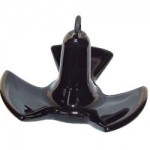It was a beautiful evening anchored off a tiny cay in Belize, enjoying cocktails with friends aboard their boat. We all were enchanted by the luminescence in the water, floating by in trails, glowing faintly and then brightly in pulses. We sat chatting until it was pitch dark and then dinghied back to our boats — 3 boats anchored a respectable distance apart. The wind was howling, but we were safely tucked away.
Imagine our surprise the next morning to find out there could have easily been a tragedy that evening. The other boat’s dinghy outboard sputtered and died on the way back to the boat. Because of the pitch black, we didn’t see them being blown with the wind past the boat. Luckily, they got the outboard restarted and returned to the boat safely. But if the outboard hadn’t started, and we didn’t hear them yell because we were down below, it could have had bad consequences.
A similar scenario happened to us at Big Major Cay in the Exumas last winter — this time it was broad daylight and we were exploring a ways away from the anchorage when our trusty outboard decided to quit. The combination of the current and 20 mph winds swiftly caught the dinghy and we were being swept away from civilization at an alarming rate. Luckily, we’d been snorkeling earlier that day and had the dinghy anchor in the boat. Down went the dinghy anchor which immediately stopped our exit. David took the outboard cover off and began working to figure out what was wrong. Luckily another dinghy from another boat saw us sitting there and came out to check on us just as the outboard fired. We asked them to keep an eye on us since our boat was almost a mile away, but made it home safely. Without the dinghy anchor, we might have drifted out of sight and been in a precarious situation.
 Bottom line: carry a dinghy anchor ALL the time, whether you’re just headed to the town dock to tie up for ice cream or dinghy fishing or exploring. Our current dinghy anchor is a folding type grapnel, probably 3 pounds hooked to 8 feet of chain and 50 feet of nylon rode. Make sure the pointy tips don’t get anywhere near the inflatable tubes! The folding grapnel works well for us because I can secure the ring around the flukes anytime the anchor is in the dinghy.
Bottom line: carry a dinghy anchor ALL the time, whether you’re just headed to the town dock to tie up for ice cream or dinghy fishing or exploring. Our current dinghy anchor is a folding type grapnel, probably 3 pounds hooked to 8 feet of chain and 50 feet of nylon rode. Make sure the pointy tips don’t get anywhere near the inflatable tubes! The folding grapnel works well for us because I can secure the ring around the flukes anytime the anchor is in the dinghy.
We originally had a fluked mushroom dinghy anchor, heavy, maybe 7 pounds, but we were always concerned about it just dragging away while we were both a long way from the dinghy snorkeling or spearfishing.
So we changed to the grapnel because we can hand set it in sand with a couple flukes buried, not likely to go anywhere.
The bottom line is no matter what you choose for a dinghy anchor, make SURE it’s in the boat anytime you get in the dinghy!
What’s your dinghy anchor set up? Please leave a comment and let us know! Cheers! Jan
















We used the fluked one, never had it drag in the Sea of Cortez — but once it did come untied while we were scuba diving. Imagine surfacing to find nothing! Swam to shore, another boat took us along the shore line and we found ours in a nasty rocky inlet.
Another big safety tip is ALWAYS to carry a handheld VHF in the dink — that way, if you need help, you’ve got something more than voice power.
We’ve always used a grapnel anchor but recently our dinghy was washed ashore because the grapnel would not hold. We puchased a Mantis dinghy anchor (Rocna makes one too) and have been amazed at the holding power. You just throw it in the water and it sets immediately.
After some close calls in the past, we also carry PFDs, bailer, search light, first aid, nav lights, outboard tools, Navionics app with track, handheld VHF, flares, smoke, and a signal horn.